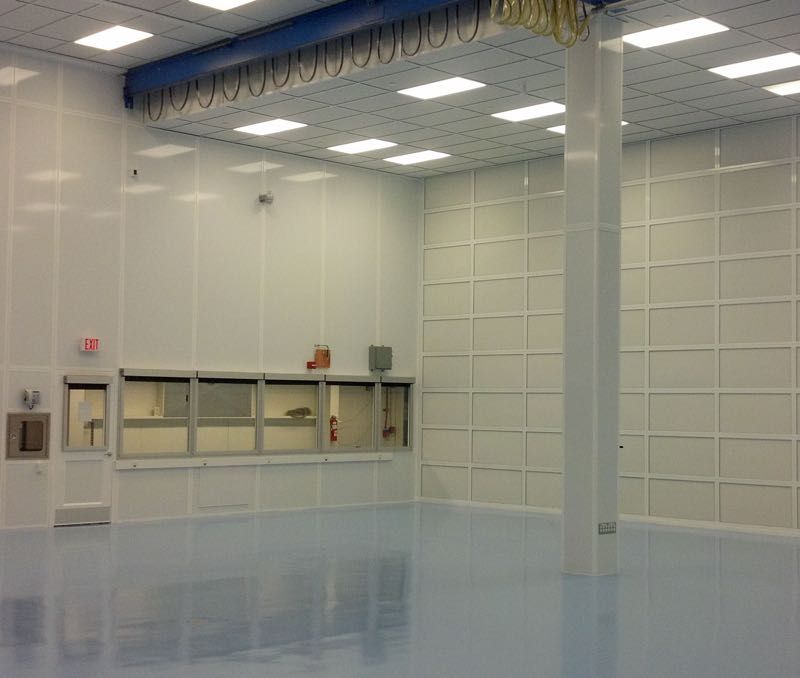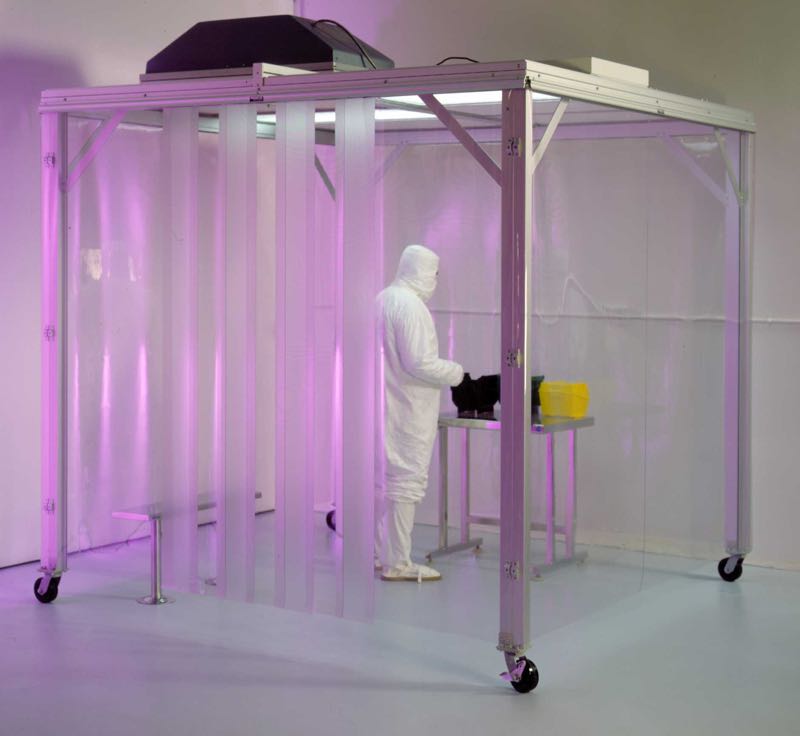After 28 years designing cleanroom systems, Kathie Kalafatis knows one thing or two about the business. As the president and CEO of the California-based CleanAir Solutions (CAS), she has spearheaded projects for the semiconductor, pharmaceutical, electronics and biotech industries in the United States, Mexico, Canada, and even further afield to customers in remote locations such as Ghana. “We take on a lot of custom applications that many companies shy away from due to risk. These are the type of jobs we love,” she says.
Kalafatis founded CAS in 1998 following a tenure in a start-up that manufactured industrial curtain systems. She saw an opportunity in that industry to utilise the curtains in portable and modular cleanrooms for critical applications. She explains: “Meeting with various customers over the years, I noticed a disconnect between what the architecture and engineering companies were asking for and what the contractors were actually able to install. Such disconnects delivered misaligned systems that left many end-users holding the bag, so to speak. So, I decided to create a company that would encompass both the design and build aspect of these critical processes to ensure a solution that would work having the responsibility for the success of the project under one umbrella: CAS.”
I decided to create a company that would encompass both the design and build aspect of these critical processes to ensure a solution that would work having the responsibility for the success of the project under one umbrella
The company has grown steadily over the past 20 years. CAS is intertwined with many different industries, so there has never been a significant downturn in business. “When the economy has affected one market sector, we were simply able to refocus our efforts to other industries,” she says. CAS is a privately-owned business and Kalafatis reveals the company achieves several million dollars’ worth of business annually and that it boasts minimal employee turnover. “Many of our employees have been with us for over 15 years,” she says.
How has CAS grown to date?
In the beginning, it was just a consulting firm, but over the past 20 years we have grown into a full turnkey design/build construction company providing cleanroom solutions nationwide and globally. We have diversified our product offering to include all necessary equipment that would be required to furnish a cleanroom or lab space completely. We also changed our focus from initially being heavily microelectronics-driven to specialise in
the pharmaceutical, medical device and biotech sectors. Each industry requires a different design approach, so understanding these nuances has really set CAS apart from our competition.
What are the main changes you have seen in the market over the years?
The main changes that I’ve seen over the past decade have been incorporating energy efficiency into cleanroom design; understanding that cleanrooms require a tremendous amount of air to be moved, filtered, conditioned and controlled.
Cleanrooms need to stay operational at all times, so implementing energy saving solutions is a huge financial benefit to the customer. There are new ways to control energy output within the selection of products employed, but the real energy saving starts up front in the design concept. Understanding how to manage the air most efficiently utilising bypass air systems, localised recirculating fan systems, and dynamic controls makes a big impact.
What segment of the market do you see performing well this year?
The new USP 800 regulation for pharmaceutical compounding that goes into effect in December 2019 will be keeping us very busy over the next year.

CAS designed and built a 2,450 sq ft cleanroom for NASA’s Magnetospheric Multiscale project at the Goddard Space Flight Center in Greenbelt, Maryland
Market opportunities
The new USP 800 regulation requires pharmacists who compound anything that falls under the classification of hazardous drugs to comply with new cleanroom guidelines for protecting both the personnel and the product. It will apply to hospitals, pharmaceutical production plants and to neighbourhood pharmacists alike. No matter the scale, facilities must upgrade the infrastructure to ensure compounding is performed inside a biological safety hood that is vented outside of the building. For many, Kalafatis says, this is challenging because most of these pharmacies are inside a medical plaza, multi-story building that have facility limitations.
What is your advice to companies dealing with process validation?
Process validation can be arduous. Working with a professional cleanroom consultant and validation consultant up front will help save you time and money. Engineering support and process support are two very different things, and both are really important to the success of any validation process.
What trends do you see in the market?
I believe the e-cigarette, vitamin supplement, and marijuana-growing markets will make a big portion of the cleanroom business going forward. These market segments weren’t even on the radar a few years ago. Modular, portable and flexible solutions will be in high demand. Of course, the large-scale businesses that have always driven the market will continue to grow; microelectronics, biotech, healthcare and aerospace. If manufacturing in these areas returns to the States, it will provide a huge influx of work in the cleanroom field.
Why do you see those segments growing?
The recent passing of marijuana legislation has opened new segments of business inside the cleanroom marketplace. In 2016
the FDA deemed e-cigarettes, hookahs and other related tobacco products would fall under the Federal Food, Drug, and Cosmetic Act. The purpose was to hold these manufactures to the same standards as the medical device and food processing businesses. The devices used to vape marijuana are the same as e-cigarettes and therefore fall under the same FDA oversight.
What type of cleanrooms are needed for these applications?
One of the dangers of electronic cigarettes is the residual metal nanoparticles that can contaminate the e-liquid during the manufacturing process. Cleanrooms are essential for maintaining contamination control during this process. Our modular, rigid panel, prefabricated cleanrooms are a good fit for this application.

Portable softwall cleanroom
Solution provider
Every project CAS has taken on has been somewhat challenging. However, there is one assignment that stands out from the rest. CAS designed and built a large-scale cleanroom for NASA’s Magnetospheric Multiscale project at the Goddard Space Flight Center in Greenbelt, Maryland. NASA’s executives said it would be impossible to accomplish due to space, schedule and financial constraints, but Kalafatis recalls CAS delivered the project with much satisfaction.
The company will then work on a project that will see CAS create a large chamber that meets an ISO Class 5 cleanroom environment for a NASA facility
She explains: “We were able to transform a shipping and receiving warehouse with no climate control into a 2,450 sq ft, 22 ft tall ISO 5 cleanroom that included a gowning room with storage mezzanine over the top, and a mechanical room that took up less than a tenth of the original space, even with 100% redundancy built in. The second phase of this project was built at the Naval Research Lab in Washington D.C. using the same parameters, but with the addition of an integrated 5-ton crane system that could be accessed through an automatic removable ceiling section, controlled room-side. The cleanroom crane allowed the spacecraft to be picked up and moved around easily without contaminating the space.”
In both phases, Kalafatis says, energy efficiencies were implemented using a state-of-the-art particle monitoring system to sense when particulate counts exceeded a specified threshold, commanding higher fan speeds and bringing the room back into spec. “This design saved NASA millions of dollars in up front expense and cost of ownership. It was a great success,” she adds.
CAS’ pipeline looks busy. The company has been contracted by the US Department of Energy to build a 1,500 sq ft multi- class cleanroom for the Stanford Linear Accelerator Laboratory. The company will then work on a project that will see CAS create a large chamber that meets an ISO Class 5 cleanroom environment for a NASA facility.
“Since we are not contracted to sell any one specific product, our customers’ know that when we provide a solution, it’s the best solution for their needs, not just want we have in our portfolio to offer. There is a great trust.”
Editor's note: This interview is featured in the August issue of Cleanroom Technology. The digital edition is available online.
